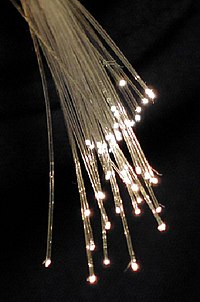
Photo from wikipedia
Abstract In thermoluminescence (TL) material dopant concentration has an important effect on their characteristics as a “radiation-sensor”. The study investigates dosimetric properties of four different concentration (4 mol%, 5 mol%, 7 mol% and… Click to show full abstract
Abstract In thermoluminescence (TL) material dopant concentration has an important effect on their characteristics as a “radiation-sensor”. The study investigates dosimetric properties of four different concentration (4 mol%, 5 mol%, 7 mol% and 25 mol%) tailor-made Ge-doped silica fibers. The intention is to seek development of alternative TL materials that offer exceptional advantages over existing passive systems of dosimetry, including improved spatial resolution, a water impervious nature and low cost. Photon beams (6 MV and 10 MV) from a clinical linear accelerator were used for irradiation of the fiber samples over radiation therapy doses, ranging from 0.5 Gy to 8 Gy. SEM-EDX analysis was also performed to investigate the homogeneity of distribution of Ge dopant concentration from the fiber samples. The results of measurement were also compared with two of the more commonly used standard TLDs, TLD-100 (LiF: Mg,Ti-7.5% 6 LiF) and TLD-700 (( 7 LiF: Mg,Ti-99.9% 7 LiF) chips respectively. The TL intensity of the fiber samples was found to strongly depend on Ge dopant concentration, with samples showing enhanced TL yields with decreasing Ge dopant concentration. 4 mol% Ge-doped silica fiber provided the greatest response whereas the 25 mol% samples showed the least, indicative of the well-known concentration quenching effects All fiber TLDs provided linear dose response over the delivered radiotherapy dose-range, the fibers also showing a weak dependence on photon beam energies in comparing the TL yields at 6 and 10 MV. The fading behavior of the different concentration Ge doped TLD-materials were also measured over a period of thirty (30) days subsequent to irradiation. The relative sensitivity of the samples with respect to standard TLD-100 were found to be 0.37, 0.26, 0.13 and 0.02 in respect of the 4, 5, 7 and 25 mol% fibers. The primary dosimetry peak, which was by far the most prominent of any other feature covered by the glow curve, was found to be around 244 °C using the most sensitive silica fiber. The study is expected to pave the way in making more comprehensive investigations aimed at defining improved TL response fiber samples.
Journal Title: Radiation Physics and Chemistry
Year Published: 2017
Link to full text (if available)
Share on Social Media: Sign Up to like & get
recommendations!